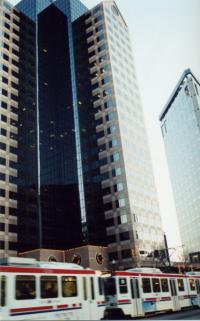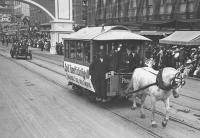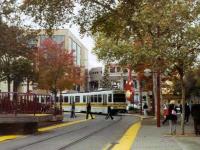A number of myths about rail transit have long been promoted by the the automobile industry, the highway lobby and other special interest groups that are opposed to balanced transportation. The most common of these myths as well as the realities are provided below:
Myth #1: Rail transit is a waste of money because it will attract relatively few riders.
Reality: In fact, most new systems have recorded very strong ridership, in some cases even far greater than the most optimistic forecasts. And ridership continues to grow as people become familiar with the systems and population density increases close to stations. For example, the Blue Line in automobile-dominated Los Angeles (from downtown to Long Beach) is one of the most successful new light rail lines in the U.S., carrying more than 85,000 riders per day on weekdays.
Likewise, the Red Line subway in Los Angeles was widely ridiculed as a boondoggle because only a few tens of thousands of people per day rode it when the first segment opened. However, when construction was completed and the line was able to operate over its full planned length (from downtown to the San Fernando Valley), ridership soared to more than 144,000 passenger trips on weekdays and is still increasing.
Myth #2: Rail transit requires very high population densities that only a few U.S. cities have in order to be successful.
 | |
| (click to enlarge) |
An example is Salt Lake City, which has a population of only 181,743 and a density of 1,666 per square mile. The population for the urban area as a whole is about a million. Its new, two-line light rail system is heavily utilized with more than 53,000 riders per day, far more than even the most optimistic original projections. This success has resulted in strong pressure to construct more lines to serve additional parts of the city and suburbs.
Myth #3: Rail transit systems should not be built because they always lose money.
Reality: This is very misleading because the investment criteria for transport, as well as for other types of public services, should be made on the basis of total costs and benefits rather than cash flow. For example, schools, police and fire departments, hospitals and libraries also all lose money on a cash flow basis but they provide very valuable services that have a substantial net benefit for society as a whole.
This argument also fails to take into consideration the fact that there are the tremendous hidden costs and subsidies of relying exclusively on automotive transport, including air pollution, dependence of foreign energy supplies, adverse effects on public health, sprawl and lack of transportation alternatives.
Myth #4: "Bus rapid transit" is superior to rail transit because it is both cheaper and more flexible.
Reality: So-called bus rapid transit (BRT) consists of running busses at frequent intervals on partially or completely separate lanes, giving them priority at some traffic signals and requiring that fares be paid before boarding.
BRT can be cheaper to build than light rail, particularly if it utilizes existing streets. But rail service can also be relatively inexpensive to establish when it runs on existing tracks.
Among the disadvantages of BRT as compared to rail transit are a smaller passenger carrying capacity, higher operating costs, less passenger comfort, greater dependence on fossil fuels, more air pollution, increased danger at road crossings when operating on an exclusive right of way and less attractiveness to potential passengers.
Myth #5: Light rail is an obsolete technology that is basically the same as streetcars that ran a hundred years ago.
 | |
| (click to enlarge) |
Myth #6: Monorail is superior to rail transit both because it is a more modern technology and can go above everything.
Reality: It is true that monorail has long captured the public's imagination because it can travel unimpeded above traffic and other obstacles and also provides outstanding views for its riders.
Unfortunately, however, it also has some serious disadvantages that greatly reduce it practicality. One is that the mechanisms for switching vehicles between beams (monorail vehicles actually run on a beam, not a rail) are bulky and cumbersome as compared with track switches for conventional steel rail systems, thereby greatly limiting the operational flexibility of monorail systems. Another is that it is impractical for monorails to operate through tunnels and at ground level, in contrast to rail transit, which can operate not only on elevated structures like monorail, but also in tunnels, at ground level and in streets and transit malls. Monorails are also very costly to build and maintain because there are very few sources for the vehicles and parts, and thus almost everything must be custom built. It is also important to keep in mind that monorails are not really anything new; the first system was built more than a century ago.
Consequently, virtually all fixed guideway transit systems throughout the world, both existing and new, use steel wheels on steel rails technology. The main exceptions are a handful of single-line systems in Japan that were built largely for demonstration purposes and where land use and other conditions are very different from those in the U.S.
Myth #7: "Fixed rail" transit is too inflexible because it can not accommodate changes in urban geography and shifting travel patterns.
Reality: The term "fixed rail" is commonly used by opponents of rail transit to imply that there is something inflexible about it. In reality, rail lines are no less flexible than what could be termed "fixed roads." In fact, it is generally far less expensive and disruptive to relocate a rail line than a freeway, in large part because of the much smaller space consumption of rail line with the same carrying capacity. When population growth occurs in some area of a city, it is typically both much cheaper and much less disruptive of the environment to extend a rail line to that area rather than extend a freeway to it.
Myth #8: The problem with rail transit is that it does not go where people want to go.
 | |
| (click to enlarge) |
Moreover, it has been demonstrated in city after city that rail transit systems actually serve as magnets for residential, commercial and other types of activity. That is, people demand to live closer to stations, as evidenced by substantially higher housing prices near stations, and other uses also congregate towards stations, thereby making the system even more convenient with the passage of time.
Myth #9: Rail transit serves mainly people who were previously riding busses and does little to attract people from their cars.
Reality: It has been demonstrated in many cities that the introduction of a well-designed rail transit line attracts not only bus riders but also many people who formerly drove. Automobile owners are attracted because of the higher standard of service that is provided by such a rail system as compared with busses, including faster speeds (due largely to not getting stuck in traffic) and greater comfort.
As one of numerous examples, the introduction of light rail service in Salt Lake City resulted in a sharp reversal of the downward trend of transit usage by attracting many people who formerly drove to work, school, etc.
The preference of the public for rail transit rather than busses is further evidenced by the fact that in cases when the former were replaced by the latter, ridership typically fell off sharply. Fortunately, such replacements have become very rare in recent decades, and now it is usually busses that get replaced by rail.
Myth #10: Advocates of rail transit want to restrict people's freedom by forcing them to use transit.
Reality: Nothing could be further from the truth. Advocates of rail transit actually want to increase people's freedom by giving them a choice. That is what freedom is all about -- choice. Some people will choose to never ride transit no matter how bad traffic congestion becomes. Others, however, will be delighted to use transit if it is fast, comfortable, quiet, convenient, safe and fairly priced. Providing this choice means that people can select automobile travel for trips for which it is more convenient (such as transporting bulky or heavy objects) and choose transit for trips for which it is most convenient.
Detractors of rail transit sometimes say that it is a type of socialism. This is said both because they believe that it is a way of regimenting people and because some socialist or communist countries have rail transit systems. But many of the countries and cities with the most vibrant capitalist economies, such as Hong Kong, Tokyo and New York, also have excellent rail transit systems.
Myth #11: Rail transit cannot reduce traffic congestion.
Reality: This is really misleading. When a rail transit line transports tens of thousands of people a day, it cannot help but reduce the amount of traffic on parallel roads. This is just elementary physics. What the proponents of this argument fail to point out is that traffic often remains congested on parallel roads because of population growth and because drivers switch from other, more congested, roads. All that is necessary to see how greatly rail transit can reduce congestion from what it would otherwise be is to look at the gridlock and chaos that results in a city in which the rail system is shut down due to a strike (a fortunately rare occurrence).
Also to be kept in mind is the fact that reducing congestion is not the only goal of rail transit, and not necessarily even the main one. Other important goals include providing an alternative, reducing expenditures for more freeways, protecting the environment and reducing consumption of and dependence on fossil fuels.
Freeways by their very nature tend to be congested as long as people are not charged for use of them at the time of use. It is the same as many other resources that would jammed if users were not charged for them. For example, movie theaters and bars would likely be much more crowded if everyone were admitted and served for free. Experiments in such places as Singapore and London have shown that congestion can be reduced very efficiently when alternative modes of transport are available by charging motorists for their use of congested road space.